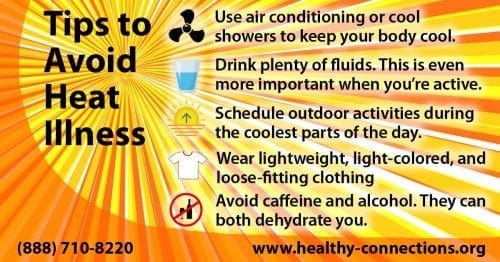 What are heat-related illnesses?
What are heat-related illnesses?
Exposure to abnormal or prolonged amounts of heat and humidity without relief or adequate fluid intake can cause various types of heat-related illness. Children and teens adjust more slowly than adults do to changes in environmental heat. They also produce more heat with activity than adults and sweat less. Sweating is one of the ways the body cools itself. Children and teens often don’t think to rest when having fun and may not drink enough fluids when playing, exercising, or participating in sports.
Children and teens with chronic health problems, or those who take certain medicines, may be more susceptible to heat-related illnesses. Children and teens who are overweight or wear heavy clothing during exertion, such as marching band or football uniforms, are also more susceptible.
Heat-related illness can occur in two ways, exertional and non-exertional. Exertional heat illness occurs when your child exerts themselves in a hot environment, such as practicing football on a hot day without any breaks. Non-exertional heatstroke occurs when a child is trapped in a hot environment. Examples of this would be an infant left in a car on a summer day or a child with disabilities left in a hot apartment without access to water.
Heat-related illness includes the following conditions based on the severity of a child’s condition:
-
Heat cramps
-
Heat exhaustion
-
Heatstroke
What are heat cramps?
Heat cramps are often the first sign that your body can’t handle the heat. These muscle cramps usually affect the legs arms, or abdomen. Heat cramps are the mildest form of heat illness and consist of painful muscle cramps and spasms that occur during or after intense exercise and sweating in high heat.
What is heat exhaustion?
Heat exhaustion can come on gradually (possibly over several days). Symptoms may include skin that is cool, most, and pail; dizziness; nausea; fainting; headache; and muscle cramps. People with heat exhaustion may also develop fast, shallow breathing and a rapid, weak pulse. Heat exhaustion is more severe than heat cramps and results from a loss of water and salt in the body. It occurs in conditions of extreme heat and excessive sweating without adequate fluid and salt replacement. Heat exhaustion occurs when the body is unable to cool itself properly and, if left untreated, can progress to heatstroke.
What is heatstroke?
Heatstroke is a Medical Emergency. Call 9-1-1. The body’s systems for cooling itself are shutting down, and body temperature can rise to 106 degrees. Look for: Red, hot, dry skin; rapid, strong pulse; throbbing headache; dizziness; nausea; confusion; and unconsciousness. Heatstroke, the most severe form of heat illness, occurs when the body’s heat-regulating system is overwhelmed by excessive heat. It is a life-threatening emergency and requires immediate medical attention.



